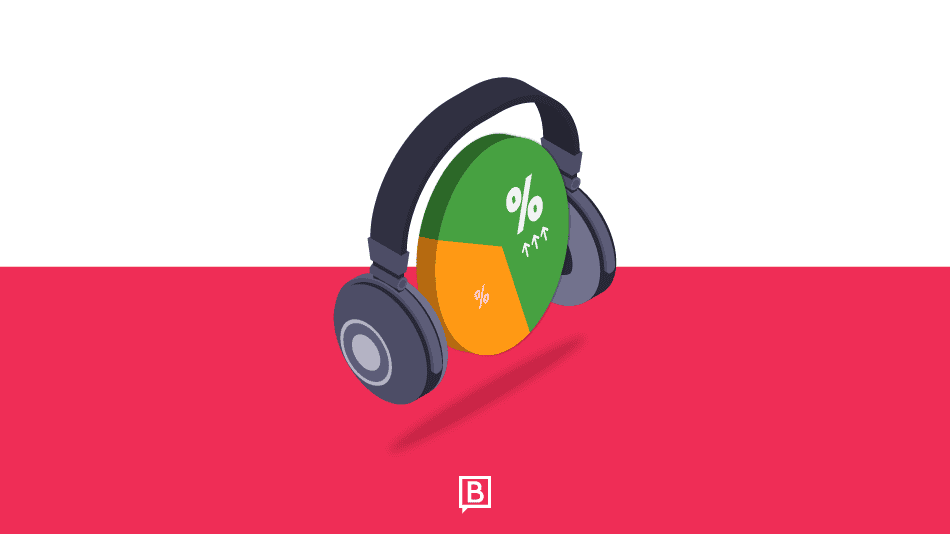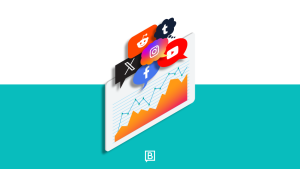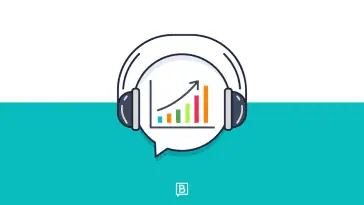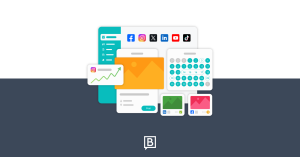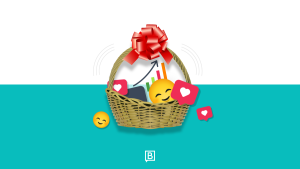Psssst! Your competitor’s complaints are your next campaign.
Most brands are only scratching the surface when it comes to social intelligence. They’re using it as a defensive tool for PR or crisis management rather than what it truly can be: a powerful strategic advantage.
That’s where competitive social listening comes in.
Instead of focusing only on what’s being said about your own brand, competitive social listening shifts your attention to what’s being said about others in your space … specifically your competitors. When you know what’s frustrating their customers, you can step in with the solution they’re not providing.
Let’s break down how this works.
The BIC Method: A Simpler, Smarter Way to Listen
There are tons of ways to “do” social listening, but at B Squared Media, we created a method that’s both simple and extremely effective.

We call it the BIC Method, which stands for:
-
Brand Listening: Monitor conversations about your own brand to understand reputation, feedback, and brand sentiment.
-
Industry Listening: Tune in to trending conversations in your broader space to stay ahead of shifts and spot opportunities.
-
Competitor Listening: Uncover what customers love (or hate) about your competition and use those insights to differentiate.
While all three types of listening are important, competitor listening is where you’ll find your biggest opportunities to steal market share.
The Power of Competitive Social Listening
Let’s say you monitor conversations about a direct competitor and notice one recurring pain point: “Their customer service is terrible. I’ve been waiting two weeks for a response!”
That’s a moment of strategic opportunity.
You can take that insight and turn it into a campaign that directly addresses the frustration:
“Hate waiting around for customer service replies? With [Your Brand], our team responds in under 24 hours. Every. Single. Time.”
This is what we call a differentiated campaign: you highlight the difference between your offering and the competition, using the customer’s own words and pain points to position your product or service as the better choice.
For another example, let’s look at Epson and HP.
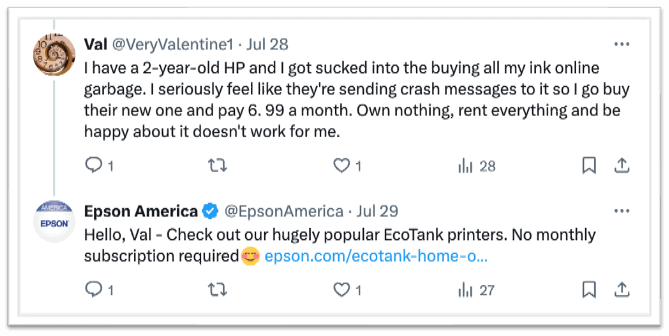
Epson is clearly using competitive social listening to see where their competitors are falling short. Let’s unpack this excellent move by Epson.
Competitive Social Listening Strategy
Epson sees someone venting about HP’s ink subscription and jumps in with a helpful, brand-forward alternative. It’s not a direct takedown, y’all. It’s a smart social media customer experience (CX) play.
This is what we call a social CX power move — not because Epson dunked on HP, but because they used the customer’s own frustration to reframe the buying conversation.
Instead of saying, “We’re better,” Epson said, “Hey Val, here’s a printer that won’t make you rage-buy ink every month.” 🙃
That’s competitive listening meets conversion opportunity. And it works. You don’t need to bash the competition. Just let their customers do the talking.
When Val aired her HP frustrations on Twitter (and let’s be real, she went off), Epson didn’t clap back. They listened. And then, they responded with a solution that answered her pain point directly:
No subscriptions. Just printing.
- That’s social care.
- That’s social selling.
- That’s what happens when you treat public complaints as CX goldmines.
If you’re only using social to push content, you’re missing the part where it pulls people in.
Takeaway: Your competitors’ complaints are your content strategy. Don’t bash. Bridge. Between their frustration and your frictionless fix.
Why Most Brands Miss This Opportunity
Many brands still see social listening as a passive task. They might pull reports or scan for brand mentions during a crisis, but they’re not using this intelligence to actively shape marketing strategy.
Worse, they often ignore what’s being said about competitors altogether. This is a huge missed opportunity!
Social media is public. If customers are complaining—especially consistently—about something, you’ve just been handed a playbook for how to stand out.
This type of insight is pure gold when it comes to crafting content, building ad campaigns, and even developing new product features.
Use Competitive Listening to Shape Differentiated Campaigns
Let’s walk through another example.
Imagine you’re a SaaS company and you notice users frequently complain that a competing product has a confusing user interface.
You might develop an ad campaign that says:
“Tired of clunky software that makes your head spin? Our intuitive dashboard helps you do more with fewer clicks.”
You’re addressing a specific pain point, but more importantly, you’re doing it in a way that’s:
-
Strategic: Because you pulled this directly from competitive insights.
-
Customer-centric: Because it’s rooted in the voice of the customer.
-
Different: Because you’re solving a real problem your competitor isn’t.
That’s the power of competitive social listening. It helps you meet customers where they already are with the exact solution they’re searching for.
Advanced Competitive Listening Strategies
If you’re ready to stop reacting and start leading the narrative, these aren’t just tactics! They’re power moves. Let’s turn that competitive chatter into conversion gold:
1. Sentiment Shift Tracking
What to watch: The tone of the crowd.
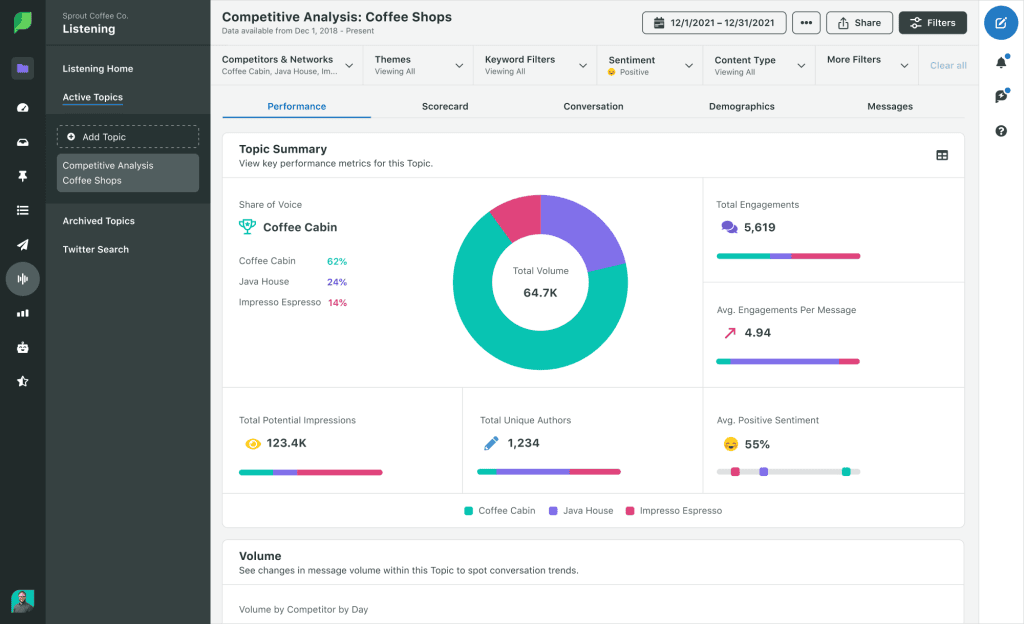
[Source: Sprout Social]
If competitor love starts turning into side-eye (think: growing complaints, “this used to be great” posts, or trust tanking), that’s your cue to step in. It’s not about dancing on their downfall! It’s about showing up as the relief they’re already looking for.
Pro tip: Layer sentiment data over time. Spikes in negativity = prime time for your “We do it differently” campaign.
2. Influencer Listening
Micro and mid-tier influencers are the new market makers. What they’re saying about your competition tells you where the wind is blowing — and whether their loyalty is up for grabs.
POV: You don’t have to pay them to pay attention to them. Track their pain points. Then subtly show up with solutions that speak their language (and their audience’s).
3. Customer Journey Listening
Map competitor complaints across the full funnel: onboarding, support, renewal, offboarding.
Your job? Outperform at every touchpoint. Turn their friction into your fuel.
For example, if you find people are bailing at onboarding? Your content should scream “onboarded in 1 day, no hand-holding required.”
If they’re stuck in support hell? Highlight your <10-min response times and human-first care.
4. Dark Social Monitoring
Remember, not everyone is tagging you (or your competitors) when they’re talking about your brand.
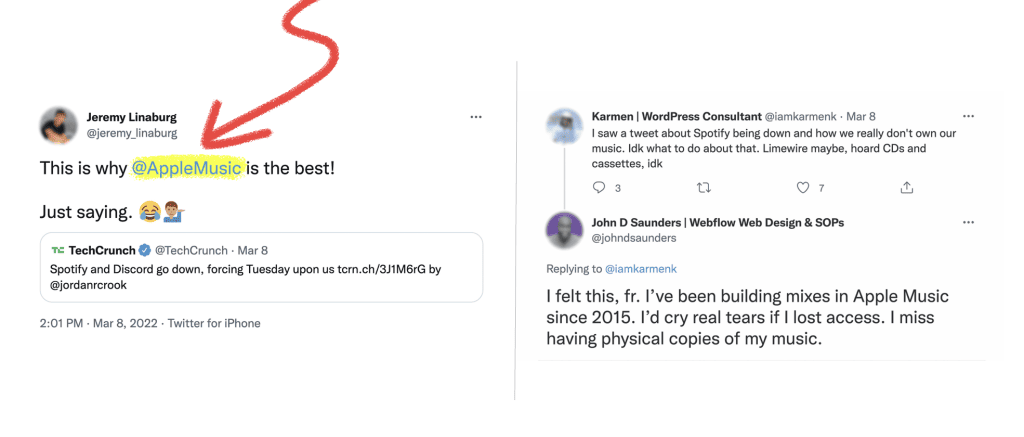
[Apple Music is mentioned on the left, but not on the right.]
What happens in Slack channels, DMs, or private Facebook groups doesn’t stay secret forever. People still drop breadcrumbs in Reddit rants, podcast comments, and Substack threads.
Your job? Train your team (or tools) to surface the whispers before they become public crises … and respond with timely content that shows you’re already on it.
5. Persona Layering
Not all complaints are created equal!
Map competitive pain points to your most valuable personas. Are decision-makers fed up with vague ROI? Are users drowning in support tickets?
Prioritize what your buyers care about and tailor your messaging to hit where it hurts (them, not you).
6. Ad Comment Mining
Real talk lives in the comments.
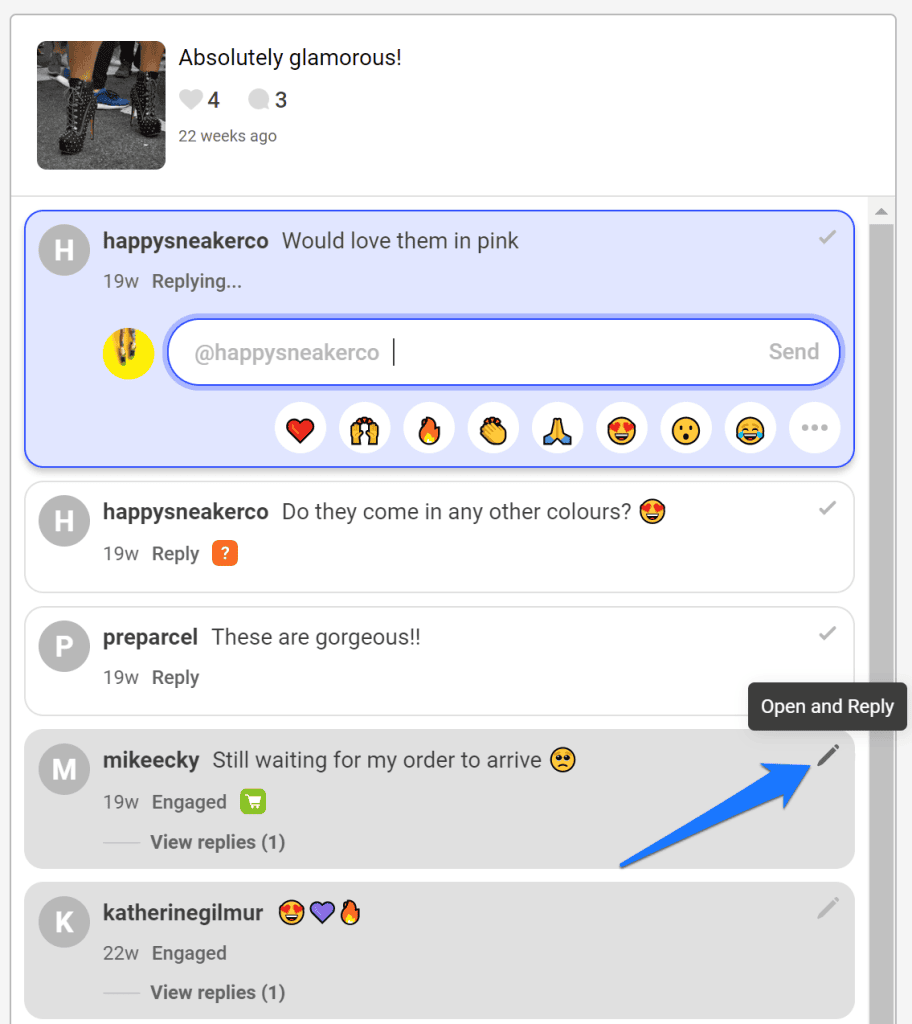
[Source: Ad comments example from Buffer]
Why should we care about ad comments when listening to competitors?
Because they’re a goldmine. And honestly? It blows our minds how many brands drop cash on ads… then ghost the comments. Like, UM, HELLO?! That’s your target audience literally raising their hand with buying questions, objections, and intent signals.
Those aren’t trolls. They’re leads.
If you’re not responding, you’re not just missing engagement… you’re bleeding revenue. Competitive brands know: the ad isn’t the end of the campaign, it’s the beginning of the conversation.
Additionally, you can forget reviews!
The juiciest competitor feedback is hiding under their paid posts. Read them like a diary. You’ll find what’s not working, what’s missing, and what people wish they had — aka the script for your next campaign.
7. Audience Language Auditing
The words people use when venting are copywriting gold.
If they say “I feel ghosted,” don’t say “timely support” — say “real humans who never leave you on read.” Mirror their phrases for instant trust and deeper resonance.
This isn’t just messaging. It’s empathy, translated.
Final Thought:
Listening is your superpower. But strategic listening? That’s your unfair advantage.
Be the brand that hears what your competitors ignore, AND speaks directly into the void they leave behind.
TL;DR: Your Competitor’s Complaints Are Your Next Campaign
By shifting from generic social media monitoring to competitive social listening, you unlock real strategic advantages:
-
Smarter messaging.
-
Campaigns that hit real customer pain points.
-
Market differentiation that’s data-backed, not guessed.
-
And most importantly… increased market share.
Because when you use competitive social listening this way, you don’t just monitor the conversation—you control it.
FAQs: How To Win More Market Share With Competitive Social Listening
-
What is competitive social listening? Competitive social listening is the practice of monitoring public conversations about your competitors—not just your own brand. It helps you spot gaps, trends, and frustrations so you can position your offer as the better, smarter, more human alternative.
-
How is competitive social listening different from regular social listening? Regular social listening = watching your own mentions. Competitive social listening = watching everyone else’s missteps and using them to win. It’s proactive, strategic, and designed to help you capture market share, not just monitor brand sentiment.
-
What tools do I need to get started with competitive social listening? Start with what’s free: Twitter/X, Reddit, LinkedIn comments, and competitor ad feedback. Then level up with tools like:
- Sprout Social
- Mention
-
Bonus points for a trained human who can read between the lines (hi, that’s us 👋).
-
Is this ethical? Aren’t we just spying? It’s not spying. It’s serving. You’re not stealing customers, you’re simply giving them a better option when they’re clearly asking for one. Competitive listening is about showing up where others fall short.
-
How often should we review competitor conversations? Weekly, minimum. Real-time, ideally. Because the faster you identify shifts in sentiment, the faster you can fill that gap, and own the moment before someone else does.
Latest posts by Brooke B. Sellas (see all)
- Outsourced Social Media Management: The Hidden Growth Strategy of Market Leaders - September 3, 2025
- Retaining Customers with Social Care: How to Use Social Proof to Build Loyalty - August 27, 2025
- I Went Viral on LinkedIn. Here’s the Good, the Bad, and the Ugly. - August 20, 2025
